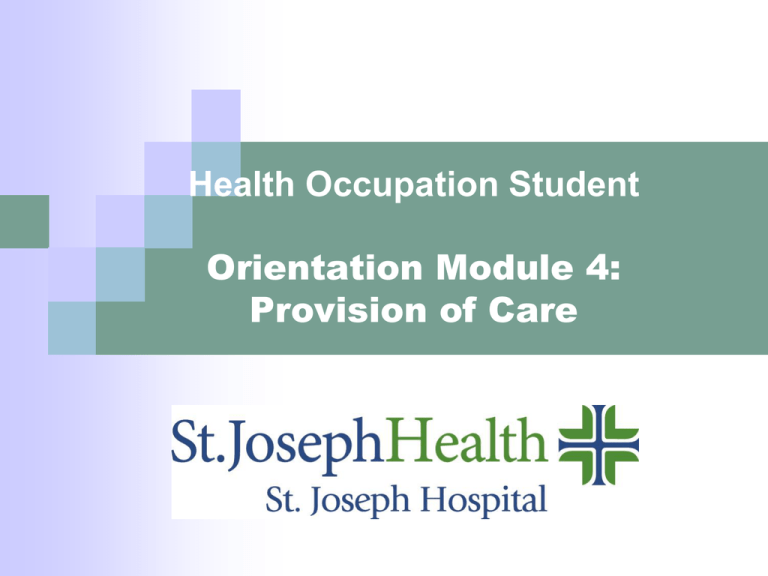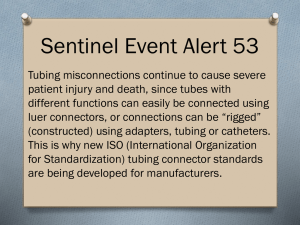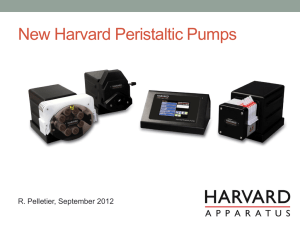Module 4 – Provision of Care
advertisement

Health Occupation Student Orientation Module 4: Provision of Care Section 1 PATIENT SAFETY GOALS Patient Safety Goals / Initiatives Background Patient Safety Goals were first established in 2002 by the Joint Commission to help accredited hospitals address specific areas of concern in regards to patient safety. These goals are hospital regulatory requirements that must be met. Accreditation surveys evaluate hospitals for goal implementation. Each year the list of patient safety goals is reviewed and updated by a panel of widely recognized patient safety experts. The following slides describe our practices for some of these goals. Patient Safety Goal Improve Accuracy of Patient Identification Use 2 Patient Identifiers Identifiers - Name and Date of Birth Check/scan armband and ask patient to state their name When to Check Patient Identifiers: Ordering/delivering meals Collecting / labeling specimens Administering Medications Blood Administration Prior to procedures, treatments and transport Patient Safety Goal Improve Communication – Physician Orders Validate Completeness and Accuracy of Verbal or Telephone Orders Write Down the order, Read Back the order Document as VORB or TORB Verbal Med Orders limited to emergencies only e.g codes Patient Safety Goal Improve Communication – Physician Orders DO NOT USE Abbreviations shown at right which are known to increase risk of errors. Physician orders containing an unapproved abbreviation must be clarified with the ordering physician. UNACCEPTABLE ACCEPTABLE “IU” Write out the words “International units” “QD” or “QOD“ Write “daily” or “every other day” “MS”, “MS04”, “MgSO4” Write Morphine Sulfate or Magnesium Sulfate Use of “Trailing” zero’s (i.e. 5.0mg) Omit trailing zero’s (i.e. 5 mg) Omission of leading zero’s (i.e. .5mg) Use leading zero’s (i.e. 0.5mg) “U” or “u” Spell out the word “units BIW Write “twice a week” DPT Write Demerol-PhenerganThorazine Dram Write “ Teaspoonful” Minum Write “drop” Patient Safety Goal Improve Communication – Hand Off Report Give an Effective “Handoff” Report When To Do a Handoff: Change of shift; transfer to different care unit; sending patient to diagnostic imaging etc. Your Role: make sure you give a verbal report to the primary RN before leaving each day. What To Include in Report: Patient’s condition, treatments, medications, services, Fall risk, isolation, code status and any recent and/or anticipated changes Limit interruptions, provide opportunity for receiver to ask/respond to questions An estimated 80 percent of serious medical errors involve miscommunication between caregivers when patients are transferred or handed-off. Patient Safety Goal Improve Communication - Patients What Needs Interpreting Patient intake H&P Consent Discharge instructions Who Can Interpret: Bilingual staff may interpret non-clinical information only Family members and friends should not be used. However, if patient insists, a certified interpreter must also be present Hospital Approved Interpreters ask the primary RN or Charge RN about these Language Barriers: Pacific Interpreters Hearing Impairment: American Sign Language; TTY and TDD devices available Patient has the right to make informed decisions regarding his/her care. Patient Safety Goal Improve Communication - Patients Use Patient – Staff Communication Boards Purpose: keep patients informed Boards are located in inpatient rooms – 1 per patient Update beginning of shift during handoff report White Boards Examples of What to Record: Date Nurse Care Partner Doctor Daily Goals Patient Safety Goal Improve Communication - Patients Round on Patients: When: Every 1 – 2 hours When providing services Accomplish scheduled tasks Address 4 P’s (pain, toileting, positioning and personal items nearby – call light, phone etc) Conduct environmental assessment (bed alarms set, IV pumps etc) Ask “Is there anything else I can do for you before I go? Communicate unmet needs to nursing Document the round on the white board The Four P’s Pain Potty Position Personal Patient Safety Goal Improve Communication – Among Caregivers Call Critical Test Results Promptly Critical (emergent) test results have been defined by the lab. These test results include critical values for blood glucose testing. All critical values must be called to the physician within 60 minutes of being resulted. Student Role: Notify the Primary RN immediately if a critical value is obtained when performing blood glucose testing. Document: Date/time of notification; Who was notified; Value reported; Readback obtained (RBO) Patient Safety Goal Improve Communication – Among Caregivers Check Safety Arm Bands – look for these high alert arm bands Applied to same limb; exception: limb restriction applied to affected limb. Allergy Band: everyone one gets an allergy band! If no allergies, write NKA on the band. DO NOT list allergies on the band. DNR Band: optional - patient may decline to wear armband. If declined, inform patient that without the communication band we may not be able to comply with their preferences. Document application / removal in nurses notes. Yellow Fall Risk Pink Limb Restriction Red Allergy Blue Isolation Purple Do Not Attempt Resuscitation Patient Safety Goal Improve Recognition/Response to Changes in Patient Condition Rapid Response Team When to Call: Concern about worsening patient condition: airway/breathing problems, neuro changes, circulation problems Student Role: If possible, check with the primary RN or Charge RN immediately for change in patient condition before calling RRT. How to Call: Who Responds: ICU RN, RT, Admin Sup Dial 7101 and enter 50. State “Rapid Response Team to _________” and identify location. Patient Safety Goal Prevent Hospital Acquired Conditions The Center for Medicare Services (CMS) has identified a number of hospital – acquired conditions that are high cost or high volume or both and could reasonably be prevented with implementation of evidenced-based practice guidelines. Occurrence of these conditions can significantly impact patient quality of life as well as hospital reimbursement for care. Current care guidelines are described on the following slides. Hospital Acquired Conditions Pressure Ulcers Falls Deep Vein Thrombosis Patient Safety Goal Prevent Hospital Acquired Conditions – FALLS Prevent Patient Falls Who Is At Risk: patient with History of falls Unsteady gait; poor balance, use of ambulatory aid Multiple health problems e.g. diabetes, lung disease, heart problems Mental status – overestimates or forgets limitations Patient Safety Goal Prevent Hospital Acquired Conditions – FALLS Standard Interventions for All Patients Maintain Safe Environment: Monitor Adequate lighting in room – night lite or bathroom lite as indicated Round Frequently (every 1-2 hours) Room Free of Clutter / Obstructions / trip hazards Bed in low position, wheels locked. Be Alert - investigate noises in patient areas Call light within reach Personal, frequently used objects within reach Directly (visual observation) or indirectly (within hearing) supervise patient while in bathroom Other Provide non-skid foot ware Obtain assist devices normally used by patient. Patient Safety Goal Prevent Hospital Acquired Conditions – FALLS Interventions for High Risk Patient Communicate Risk: Yellow slippers, armbands and Fall Risk door signage Implement actions to prevent falls Assist out of bed/chair Use of mobility devices Do not leave patient unattended in bath room – keep within arms reach Use Safety Devices Activate Bed alarms: verify bed connected to call light system and bed alarm activated Patient Safety Goal Prevent Hospital Acquired Conditions – Pressure Ulcers Prevent Pressure Ulcers Who is At Risk: patients with Limited ability to change or control body position Inadequate food intake Sensory impairment in extremities; limited responsiveness Bed bound or chair bound – not ambulating Skin frequently moist due to urine or stool Patient Safety Goal Prevent Hospital Acquired Conditions – Pressure Ulcers Promptly Report to RN: Observed red/pink areas or skin breakdown especially over bony prominences or under devices e.g. nasal cannulas, SCDs, anti-embolic hose etc. Patient Safety Goal Prevent Hospital Acquired Conditions – Pressure Ulcers Preventive Interventions - S Surface K Keep Turning I Incontinence N Nutrition Save Our Patients Skin Keep linen wrinkle free. Check for plastic caps in bed. Monitor for device-related pressure areas e.g. O2 tubing, cervical collars, SCDs, anti-embolic hose. Cushion / protect skin in high risk areas. Float heels. Turn, turn, turn. Offer assistance with toileting. Notify staff if patient incontinent. Use skin cleansers/moisturizers promptly after each episode of incontinence. Provide assistance with meals. Ensure access to supplements. Accurately document intake and output. Patient Safety Goal Prevent Hospital Acquired Conditions – VTE What is VTE: Who is at Risk: Venous thromboembolism (VTE) is a blood clot that forms in the deep veins (DVT), breaks off and travels in the veins to the lungs. It can become a life-threatening pulmonary embolism (PE). Older patient Major surgery; orthopedic surgery Immobility Trauma Central line Obesity Positive history for DVT or PE If at High Risk: Sequential Compression Devices (SCDs): If ordered, ensure they are correctly applied and turned on when in bed and up in chair; Anti-Embolic Hose: if ordered, remove every shift x 30 minutes; monitor skin for breakdown Patient Safety Goal Identify Patient Safety Risk - Suicide Suicide of a patient while in a staffed, round-theclock care setting is a frequently reported type of sentinel event. Who is at Risk: appropriate patients are assessed for mental illness, chemical impairment, suicidal ideation or judgment deficits that pose risk of harm to self or others. Safety Precautions: Depending on Assessed Risk Level, Precautions May Include: Frequent close observation; sitter if indicated Maintain safe environment: removal of equipment and supplies and objects from patient room that could be used for self harm; use of plastic utensils and paper goods. Provide prevention information (crisis hotline) at time of discharge. Patient Safety Goal Prevent Wrong Site/Procedure/Person Surgery The Universal Protocol Elements: apply to all settings including bedside procedures where consent is required. 1. Pre-Procedure Verification: verify the following Signed consent which matches physician order Updated history and physical; pre-anesthesia assessment Diagnostic test results available Procedure prep requirements met Any required blood products, implants devices and/or special equipment available SCIP measures met e.g. antibiotics given 2. Surgical Site Marking Required for all incisions, punctures and insertions Performed by Surgeon, PAs (SJH only) or Proceduralist Involves patient Permanent marker used to write initials near surgical site; Visible after draping Patient Safety Goal Prevent Wrong Site/Procedure/Person Surgery 3. Procedural Time Out Every one participates Correct patient, procedure, consent, Correct position/site/side; visible site mark Antibiotics given; prep agent and fire risk score; safety precautions for patient history/med use taken Relevant images and results Implants, blood /blood products and special equipment available if applicable Recognition / Prevention – Malnutrition/Aspiration Malnutrition and Aspiration Who is at Risk: patients are screened on admission for the risk factors shown at right. Measures to Reduce Risk: Assist patients with meals as indicated; Provide / encourage consumption of supplements etc. Document diet intake – if it isn’t documented we cannot evaluate how are patient is doing. Risk Factors • Unintentional weight loss • Decreased appetite • Difficulty eating • Contributing Minor/Chronic Diseases or Factors e.g. renal disease, pressure ulcers, tube feeding, Infection Recognition - Sepsis/Severe Sepsis What is Sepsis: Sepsis is a potentially life-threatening complication of an infection. It occurs when chemicals released into the bloodstream to fight infection trigger inflammation throughout the body. Inflammation can damage multiple organ systems, causing them to fail. If sepsis progresses to septic shock, blood pressure drops dramatically, which may lead to death. Early recognition and treatment of sepsis is essential. Sepsis Screening is completed on Admission and Every Shift by the RN Infection Recognition - Sepsis/Severe Sepsis Your Role: Promptly report to the RN vital sign changes that match sepsis criteria. SIRS* Criteria SIRS = 2 or more criteria met SIRS* Severe Sepsis Criteria MAP < 65 mmHg x2 > 2mg/dl Heart Rate >/=90 Creatinine Temp =/>38 C or < 36 C ALOC RR >/= 20 SBP <90 x2 WBC <4 >12 or >10% bands SBP 40 mmHg Systemic Inflammatory Response Syndrome New or O2 Needs UO <5mg/kg/hr x >2 hrs Bilirubin > 2mg/dl INR >1.5 or PTT >60 sec Lactate > 4 mmol/L Adverse Event Prevention – Tubing Misconnections The Problem The following events were reported by the Food and Drug Administration. Blood pressure tubing connected to IV line by family member – patient died. IV tubing connected to nasal cannula – patient went into CHF. IV tubing connected to feeding tube by family member – no harm as identified quickly. Feeding tube connected to trach tube – patient died. IV Tubing connected to trach cuff – patient died. Oxygen tubing attached to IV tubing – patient died. Adverse Event Prevention – Tubing Misconnections The Solution Increase lighting in a darkened room before connecting or reconnecting tubes or devices. Trace the tube or catheter from the patient to point of origin. Do NOT force connections Never use a standard luer-lock syringe for oral medications or enteric feedings – use slip tip syringe. Reconcile lines as part of handoff with change of shift, patient transfer, return from procedure. Patient / family education – DO NOT connect or disconnect lines. Get help! CENTRAL LINE Attach to IV tubing going to CL PERIPHERAL LINE Attach to IV tubing going to peripheral line ARTERIAL LINE Attach to IV tubing going to arterial line ADDITIVE Attach to IV tubing of any IV solution that has med added i.e. NS with KCL IRRIGATION Attach to irrigation tubing DRAIN Attach to drain – urinary catheter, hemovac, jackson pratt, penrose, NG ENTERAL FEEDING Attach to formula tubing FEEDING TUBE Attach to feeding tube – Gtube, J-tube, nasal feeding, PEG tube, Keofeed Adverse Event Prevention Use Tubing Labels Place label on the tubing adjacent to the connection site – where tubing connects to patient Continue to use IV Tubing Change Stickers (Mon, Tues etc.) OTHER Section 2 RESTRAINTS RESTRAINT Indications for Use Patient behaviors that may lead to the use of restraints fall into two categories as described below: Non Violent Behavior Attempting to pull out tubes, drains, or other lines medically necessary for treatment and is unable to comply with safety instructions Attempting to get out of bed and unsteady gait – at risk of falling and is non compliant with safety instructions. Violent, Self Destructive Behavior Physically assaultive to others or is highly agitated and assaultive behavior is preeminent e.g. Code Grey type individuals Physically harmful to self (i.e. attempting suicide, selfmutilation, hurting self, etc.) RESTRAINT Indications for Use Before restraints can be initiated for these patient atrisk behaviors: Causal Factors are Considered: Alternatives Considered / Attempted: Identify medical problems that could be causing behavioral changes e.g. increased temp, hypoxia, low blood sugar, electrolyte imbalance, drug-drug interactions Hiding tubes/lines, frequent rounding, reorientation, family intervention, companionship, mobility, distraction e.g. folding wash cloths; use of alarm devices Physician Order is Obtained: only RN’s or Physicians can initiate use of restraints; RESTRAINT Plan of Care – Student Role Monitor / Assess for: Observe patient/device for correct application – doing no harm Remove device and provide ROM Provide for personal care needs – toileting, food, fluids, pain medication Take vital signs as ordered- Promptly report any changes or concerns to RN Non Violent Observe for safety Q60 minutes Monitor/Assess Every 2 Hours Self Violent, Destructive Observe for safety the patient Q 15 minutes Monitor/Assess Every 1 Hour RESTRAINT Devices / Safe Application General Guidelines: Proper body alignment Call button can be used Patient’s head is free to rotate when in the supine position. When possible, head of bed slightly elevated to reduce risk of aspiration. Secure straps to bed or chair frame out of the patient’s reach using quick-release ties. DO NOT secure to mattress or side rail Side Rails Three side rails up equals safety Four side rails up equals restraint except for situations such as seizure precautions, age appropriate, pre/post anesthetic/sedative meds, vest restraint usage. Note: gap in side rails must be covered when used with vest. RESTRAINT Devices / Safe Application Wrist Restraints Apply Correctly: Allow one finger width between skin and device to ensure adequate circulation Remember to remove restraint and provide ROM every 2 hours. Monitor Use: soft tissue not too tight cutting of blood flow, causing limb swelling or skin abrasions. Vest Restraints Ensure right size and fit: Must fit at the waist and enable one flat hand to easily go under waist band. Apply correctly: Opening in the back; DO NOT criss-cross straps directly behind patient; side rails up with gap pads Monitor Use: device not “choking” patient or impairing breathing Section 3 Abuse, Assault and Neglect Reporting Abuse, Assault, Neglect Reporting Who has Duty to Report? All physicians and health care providers What Must be Reported: Abuse of Patients Received from Licensed Health Facilities Abuse of Elders and Dependant Adults Child Abuse Sexual Assault Adult Patient Abuse or Assault (includes spousal and domestic abuse) Abuse, Assault, Neglect Reporting How to Identify Possible Victims Consider the possibility when: THE PATIENT: History is incompatible with injuries. Has unusual injuries and/or unexplained bruises, lacerations, fractures or multiple injuries in various stages of healing. Presents with malnutrition or dehydration (not illness related), failure to thrive and/or poor physical hygiene. Has repeated ER visits, hospitalizations or a history of prior physical abuse. Delayed in seeking medical care. THE PARENT / SPOUSE / CAREPROVIDER: Refuses to leave the patient’s presence despite the patient’s wishes. Offers conflicting, unconvincing or no explanation for patient’s injury. Delayed in getting medical care for the patient. Action to Take Notify the primary RN immediately of your suspicions.







